




By Bailey Daniels STATESMAN REPORTER
On Oct.1, small local business Fun Unlimited opened a new location at 1950 North Main Street. This reopening came after months of searching for a new space due to the closure of Cache Valley Mall in April.
Fun Unlimited buys and sells various items such as video games, vinyl records, books and video game consoles. Owner Scott McUne had difficulty securing a new location for his Logan store, temporarily moving most of his inventory to his other locations in Provo and Ogden.
“We probably had about five or six different places that looked really positive, but they fell through. So it’s been frustrating,” McUne said. “I’ve been driving back and forth to Provo to work at the store there.”
After securing a deal with the new location’s owner, they have been moving in since the beginning of the month. The location previously housed multiple other businesses.
“It was actually a mattress place, a hair-cutting place and a mortuary,” McUne said. “My kids were like, ‘Great, we went from the haunted mall to here!”’
The old location doubled as an arcade, housing various machines such as a dance game called Pump It Up Pro 2024 and Space Invaders Frenzy.
“We’re planning on making an arcade room, but this location doesn’t have the height for some of those games, so we won’t be able to fit as many of them,” McUne said. “We’re talking to the man who owned the coin-pusher game and seeing if we can fit in the boxing game we used to have.”
August Draper, a Logan resident, frequented Fun Unlimited’s previous mall location and went to the new location on opening day.


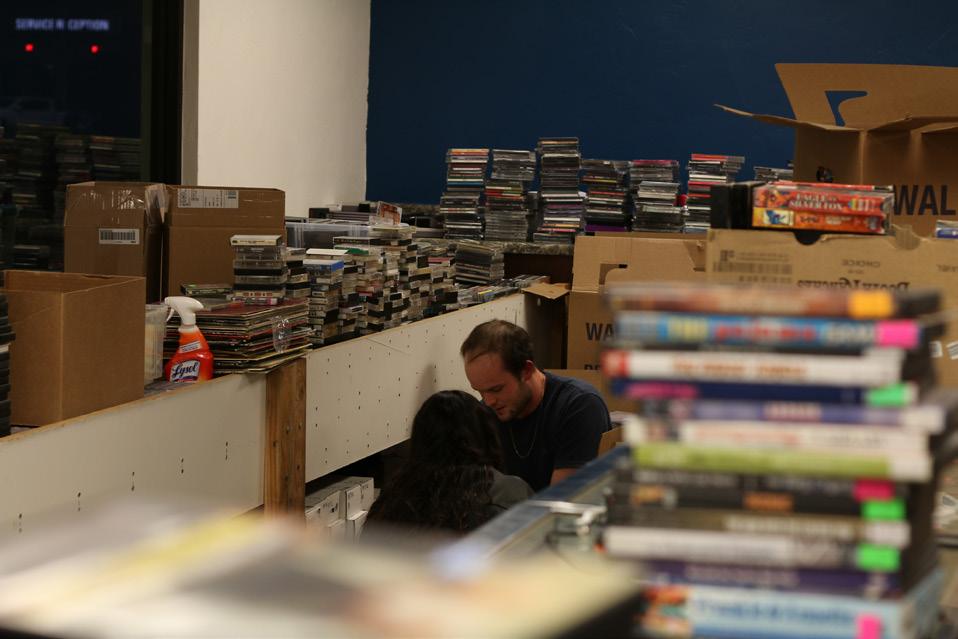
“Fun Unlimited’s new location is in some ways nice, but largely missing what made the last location charming. It felt like a private area to find anything nerdy you could think of,” Draper said. “The new location is off to the side of a highway, tucked into a building with low ceilings and faded parking spots. The building is much smaller than the last location, and while a large portion of the movies and games remain, practically everything else has been gutted.” In this increasingly corporatized town it is nice to have a small, locally owned business show resilience, but I don’t know if that is good enough when the competition is in many ways better,” Draper said.
The staff are still relocating and stocking their inventory, and they hope to be finished in time for the holiday season.
“Within the next few weeks, I think it will look completely different in here,” McUne said.
Fun Unlimited’s current hours of operation are 10 a.m. to 9 p.m. Monday to Saturday and noon to 6 p.m. on Sundays.
“Come in and plan on looking for a little bit, but come and support us so we can continue to afford the rent. The rent has been all over the place after the mayor eliminated 400,000 square feet of retail space,” McUne said.

— bailey.daniels@usu.edu
By Aubrey Holdaway STATESMAN REPORTER
Get ready, film lovers — the 2025 Sundance Film Festival is set to return this January with a new lineup of films and voices.
Tickets went on sale Oct. 23. This year, the Sundance team offers specialized options, including passes designed specifically for locals and young adults.
Basil Tsiokos, one of Sundance’s senior programmers, encourages students and other young adults to take advantage of these passes.
“We very much encourage young audiences to come out and see what we have to offer,” Tsiokos said.
The Salt Lake City Young Adult Pass was designed for attendees aged 18-25. For $300, it provides unlimited priority access to Salt Lake City screenings.
“That one is going fast,” Tsiokos said. “If folks are interested, we'd encourage you to pick that up soon because it looks on track to sell out.”
For young adults who are interested in the filmmaking process, the Ignite ticket package is another option. It includes an invitation to exclusive Ignite events, 10 tickets to in-person screenings, select screenings with live introductions and Q&As by filmmakers, short films and episodic programs.
“It’s a really important program we do as part of the Sundance Institute,” Tsiokos said. “It provides opportunities for young filmmakers to learn more about the filmmaking process, to attend meetings and events with some of the filmmakers.”
Grace Warner, 23-year-old Utah native and self-described cinephile, has worked with Sundance for the past three years. She encourages young adults to take advantage of these opportunities.
“Sundance has helped me to figure out my career aspirations as well as taught me so much about professionalism in media,” Warner said. “I love the Park City experience, so I would recommend the Ignite pass, though both are amazing options.”
Despite decades of hosting the festival in Utah, the Sundance Institute has been pursuing the possibility of relocation. A press release from Sept. 12, 2024 named Boulder, Colo.; Cincinnati, Ohio; and Salt Lake City/Park City, Utah, as the finalists for Sundance’s location after the 2026 festival.
Tsiokos says the decision will be made and announced in the late winter or early spring of 2025.

“We are still in the process of making the final determination, but we're really happy Utah is still in,” Tsiokos said. “We are factoring in a lot of different things as we figure out what we're doing, but the next two festivals will still be in Park City and Salt Lake.”
There are concerns that if Sundance leaves Utah, it will be an economic detriment to the state. Sundance provides $118.3 million in Utah's gross domestic product, 1,608 jobs for Utah residents, $63 million in Utah wages and $12.8 million in state and local tax revenue.
“The impact the Sundance has on the local community is astronomical,” Warner said.
However, the possible impact of losing Sundance isn’t just about economics — it’s personal for residents.
“Everyone there is hungry to create something, make an impact on the world or learn something new,” Warner said. "I have been changed by seeing such intelligent, creative and caring people accomplish their goals.”
For now, Sundance 2025 is moving forward in its usual Utah locales, and Tsiokos encourages anyone and everyone to come.
“Sundance sometimes can feel like an insider situation for filmmakers, and we're trying to combat that idea,” Tsiokos said.
“There are few places like this that bring together so many different kinds of people, so take advantage of it in whatever way that makes sense for you.”
As a young adult herself, Warner encourages students and young adults in particular to attend.
“Go to the screenings, go to cinema cafe, volunteer,” Warner said. “You will meet friends from across the world and make so many amazing career connections. More than anything, it's just a fun experience.”
As the festival draws nearer, those interested in attending are encouraged to visit Sundance's website to explore ticket options and stay updated on schedules and screenings.
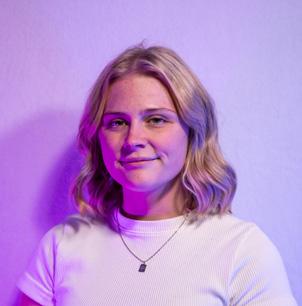
Aubrey Holdaway is a senior studying print journalism. She loves short film and Park City and is having a lovely time in David Wall’s documentary film class.
— a.holdaway@usu.edu

By Essence Barnes STATESMAN REPORTER
Every year from July to October, groups of sustainability and community-oriented volunteers gather together to take part in a local harvest rescue aimed at reducing food waste and bolstering food access.
The USU Harvest Rescue program is located under the Christensen Office of Social Action and Sustainability, a subgroup of the university that promotes sustainability and service among students.
Kate Anderson is the student lead of the USU Harvest Rescue.
“Our main goal is to minimize food waste and increase food security,” Anderson said. “We harvest from local community members — anyone who has excess produce from their trees or gardens — and we get volunteers to go harvest.”
The harvest rescue group collects produce that may have otherwise been wasted, ensuring the food is utilized to its fullest potential before being discarded.
“Sometimes people are just not physically able to harvest themselves, and so we are able to provide that help to them,” Anderson said. “People are really grateful that their fruit is not going to waste.”
Students, locals and tree and garden owners can aid in rescuing excess produce by signing up to volunteer or by registering their produce plants to come and be harvested by the group.

lower quality produce into fruit leather or applesauce.
This process of harvesting and donating excess from local trees and gardens is known as gleaning: a way to provide communities and low-income individuals with fresh produce that they may otherwise have not had access to.
According to the U. S. Environmental Protection Agency, over one third of food produced in the U.S goes to waste and makes up roughly 24% of landfills.
“People waste billions of pounds of food per year, and these can account for billions of meals,” Anderson said. “One in eight people in Utah are facing food insecurity.”

“We’ve harvested 13,000 pounds of produce this year,” Anderson said. “It is crazy to think that is all produce that could have gone to waste.”
Once harvested, the fresh produce is donated back to the community where locals can access it free of charge.
“All of our harvest is donated to food pantries such as SNAC on campus or the Cache Community Food Pantry,” Anderson said. “Sometimes we work with Families Feeding Families, Porch Pantry or Loaves and Fishes.”
The rescue group also works with USU Extension to turn

Essence Barnes is a second year student majoring in journalism and minoring in environmental studies. She enjoys reading, writing and caffeine.
— essence.barnes@usu.edu

By Lacey Cintron STATESMAN REPORTER
The word “creepypasta” likely brings a few images to mind — from Slenderman and Jeff the Killer to Momo and the Rake. These shadowy horrors have haunted the childhoods of many 2000s babies, leaving behind an indelible legacy on internet horror.
On Oct. 23, associate professor of folklore Lynne McNeill spoke on the evolution of traditional folklore into the digital realm.
Today, contemporary folklore includes memes, urban legends and perhaps most notably, creepypasta. One of the most iconic figures in digital folklore is the tall, suited and faceless creature known as Slenderman.
Created in 2009 as part of a photoshop contest, images and stories of Slenderman spread like wildfire, sparking fanart, fiction, theories and video game spinoffs. Slenderman’s infamy culminated in the well known case involving two 12 year-old girls stabbing another girl, almost killing her, “to appease Slenderman.”
“This caused a widespread panic,” McNeill said in her talk. “Parents were wondering, ‘Who is creating this content?’ and ‘Is my child going to drag my friend into the woods and stab them?’ So people began searching, and what they found was this mix of rumor, legend, art, horror and games.”
The ambiguity of Slenderman is a large part of why he became an internet legend. People spread myths about “slender sickness,” a fictional condition where a person gets chills if Slenderman was near. Video games such as “Slender: The Eight Pages” popped up, and web series like “Marble Hornets” appeared, all in an attempt to tell and spread the story of Slenderman.
what folklore means,’ perspective but when you start digging into it, you realize maybe you don’t totally have an understanding of what it means.”
Folklore like Slenderman is only possible via crowdsourcing, a process which is amplified and accelerated due to the capabilities of the internet.
“The second thing I hope people took away was the idea that folklore on the internet isn’t frivolous, silly or even malicious,” McNeill said. “It’s really doing some heavy cultural communication for us — It’s articulating things so we can hold them at a distance and understand something about ourselves.”
The stories which reach mass popularity are often stories which include some element of fear or danger. Psychologists and scientists around the world have wondered why. According to Harvard Business Review, one reason may involve mental stimulation and increased adrenaline.
characters has long been a common theme in popular media.
“I think the kind of traditional fears that we see crop up in scary folk legend are things that are helping us do internal processing of stressors, fears and anxieties but in this culturally shared way,” McNeill said.
According to McNeill, Slenderman may be a reflection of cyberbullying and threats to children in a digital world.
“One folklorist did a study on children who’d never heard of Slenderman online, only on the playground, and compared their descriptions of ‘slender sickness’ to the CDC documented signs your child might be being bullied,” McNeill said in her talk. “They found an almost perfect overlap.”
Slenderman no longer carries the weight he once did at the height of his popularity almost 15 years ago. In 2024, new horrors are on the rise.

“This is the desired outcome of creepypasta,” McNeill said in her talk. “You want your story to get picked up and told by other people.”
“There are two main things I hope people took away from the talk,” McNeill said. “One is that folklore is a lot more broad and applicable then people seem to think it is.”
When thinking about folklore, classic tales like “Little Red Riding Hood” or “Hansel and Gretel” may come to mind.
“For a long time, folklore has been defined by its oral nature,” said Afsane Rezaei, associate professor of folklore studies. “It was ideally shared by people in a face to face environment, in small, close knit communities.”
According to the American Folklore Society, folklore is defined as “our cultural DNA.” Folklore is the way people share what they perceive as important, encompassing art, stories, knowledge and tradition.
“One of my favorite things to do as a professor of folklore is introducing this new way of understanding folklore,” McNeill said. “People have a sort of, ‘Sure, I know
“Fear is a necessary sort of emotion that if we don’t have a lot of cause to feel it in our daily lives, it’s something that we might be inclined to seek out in a cathartic way,” McNeill said.
Another theory views horror media consumption as a means to process the real fears in daily life.
“Processing fear and anxiety about one thing helps us process fear and anxiety about other things,” McNeill said. “Like when you feel buried under school work and you know you need to get caught up, but instead you clean the living room. You’re doing the type of work that needs to be done, but in a different realm.”
Popular horror media can also act as a reflection of and a means to process larger societal fears.
“Modern folklore is an extension of the types of things people have been dealing with all along,” Rezaei said. “A lot of people are concerned about their children. They’re constantly worried about new threats like the internet and social media. These fears are put into these generic forms, like Slenderman who symbolically stands for the threat of social media.”
Projection of real world fears onto fictional stories and
One such character is Loab. Loab first gained traction in 2022 when Steph Maj Swanson, through a series of AI image prompts, created an uncanny image of a woman with bloodied eyes holding unidentifiable objects. Further prompts from this image spawned increasingly disturbing results.
“I find this new Loab phenomena very interesting,” Rezaei said. “It’s going to be very interesting to see how these new examples of AI monsters change.” The images have sparked debate over the origins behind Loab and why AI produced such images, with many saying Loab is a dark entity living within AI.
“Loab is such a good example of the new kinds of horrors arising,” McNeill said. “AI is such a hot topic and is something we are excited about and equally, if not more, worried about.”
As new fears creep up and more stories are told, the internet continues to play a crucial role in contemporary folklore.
“These fears become concrete in folkloric forms, even when they aren’t substantiated,” Rezaei said. “It’s a matter of how widespread this material is on the internet and that they relate to an inherent anxiety.”

Lacey Cintron is majoring in psychology. She loves learning about the human mind, sharing stories and naps.
— lacey.cintron@usu.edu
By Avery Truman STATESMAN REPORTER
In the middle of the desert, a university sends students to Australia to learn about coral, will offer a marine biology major and is partnering with one of the biggest aquariums in North America. Utah State University is taking the initiative to make Utah a place where marine science is a feasible option when the nearest ocean is hundreds of miles away.

As an environmental studies major, most of my courses teach the importance of the ocean to every ecosystem — even the landlocked ones. It seemed obvious to me that any university that studies natural resources would also teach marine science.
It was impossible for kids fascinated by sea creatures to pursue their interest as a career in Utah until recently. Now, with the official partnership with USU and the Loveland Living Planet Aquarium in Draper, Utah, there’s a promise of a path where these dreams can be achieved.
The aquarium was the first in the Intermountain West and is home to over 4,000 animals from playful otters to a graceful octopus. Once their expansion project is completed, it will be the largest aquarium in North America.
I had the honor of being asked to represent USU at the signing ceremony by my previous professors Edd Hammill and Trisha Atwood, two remarkable scientists who forged the path for this partnership. On Oct. 25, representatives from both institutions gathered in the aquarium’s ballroom to witness the start of a collaboration intended to change the science scene in Utah for generations.
The audience was surprised when Hammill and an aquarium diver joined the sharks in their tank to display signs representing their respective organizations during the signing, holding hands to signify the partnership to come.
The Quinney College of Natural Resources already offers its watershed science students a minor in marine science and several courses that teach about the ocean. USU offers a study abroad experience during a summer
trip to Heron Island, a pristine spot on the Great Barrier Reef and home to a world-renowned research station. I first met Hammill and Atwood when I had the opportunity to join this trip in the summer of 2023. From swimming with sharks to applying real-life research techniques on the reef, I returned to Utah changed for the better.
Learning about the ocean while immersed in its vast ecosystems that seemed so ancient and strong yet fragile, changed my perspective on everything I knew about the Earth. This was my awakening into the world of marine science.
Not all students are lucky enough to travel all the way to Australia to have such an awakening, making USU’s partnership with the aquarium more important than ever. Inspirational moments that happen on a reef are also possible at the aquarium where hundreds of children visit to learn about their favorite animals and more importantly, how to protect them.
The changing climate threatens everyone who calls this globe home — human or not. With sea levels rising and ocean acidification increasing, more people must join the effort to start acting on ocean science.
In Australia, it was clear how humans had impacted the reef. Coral bleaching, habitat loss, plastic pollution, overfishing and dead zones are only a few of the threats the ocean is facing.
I am overjoyed the aquarium is adding several labs and classrooms to their building to spread knowledge of the marine sciences.
During a tour of the construction zone, I walked through the new classrooms that will teach desert-raised students about the oceans they rely on. The aquarium is also adding various exhibits to give its current residents more room. Their Komodo dragon Raja is expected to outgrow his current enclosure, so a new one is being built with his needs in mind.
The new space is deceivingly large and will include beautiful skylights on slanted ceilings to let in natural light. I can’t wait to see what kind of inspiration it strikes in its
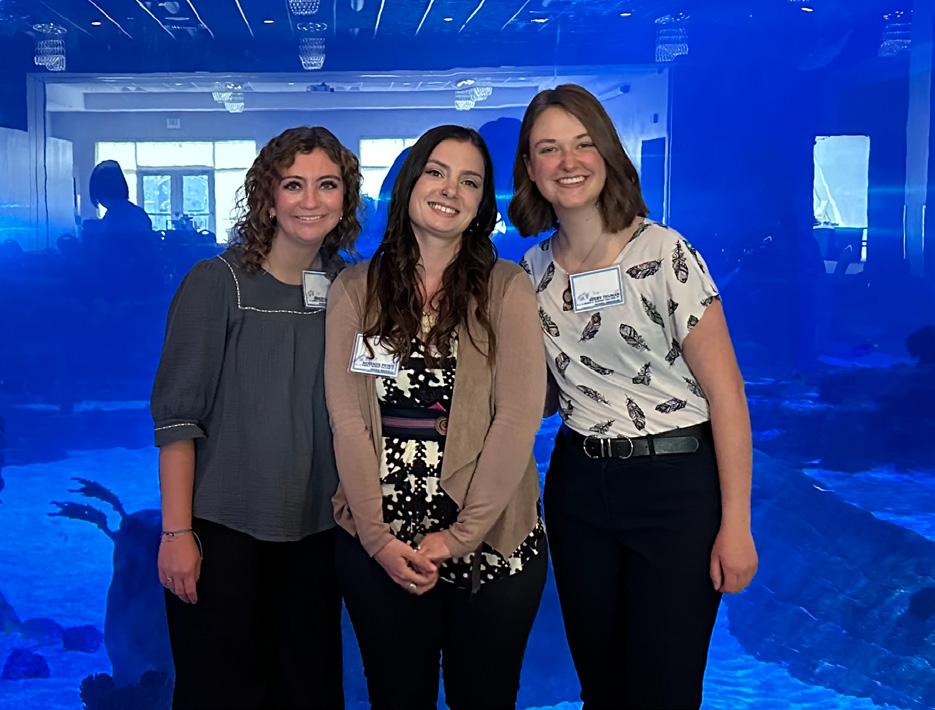
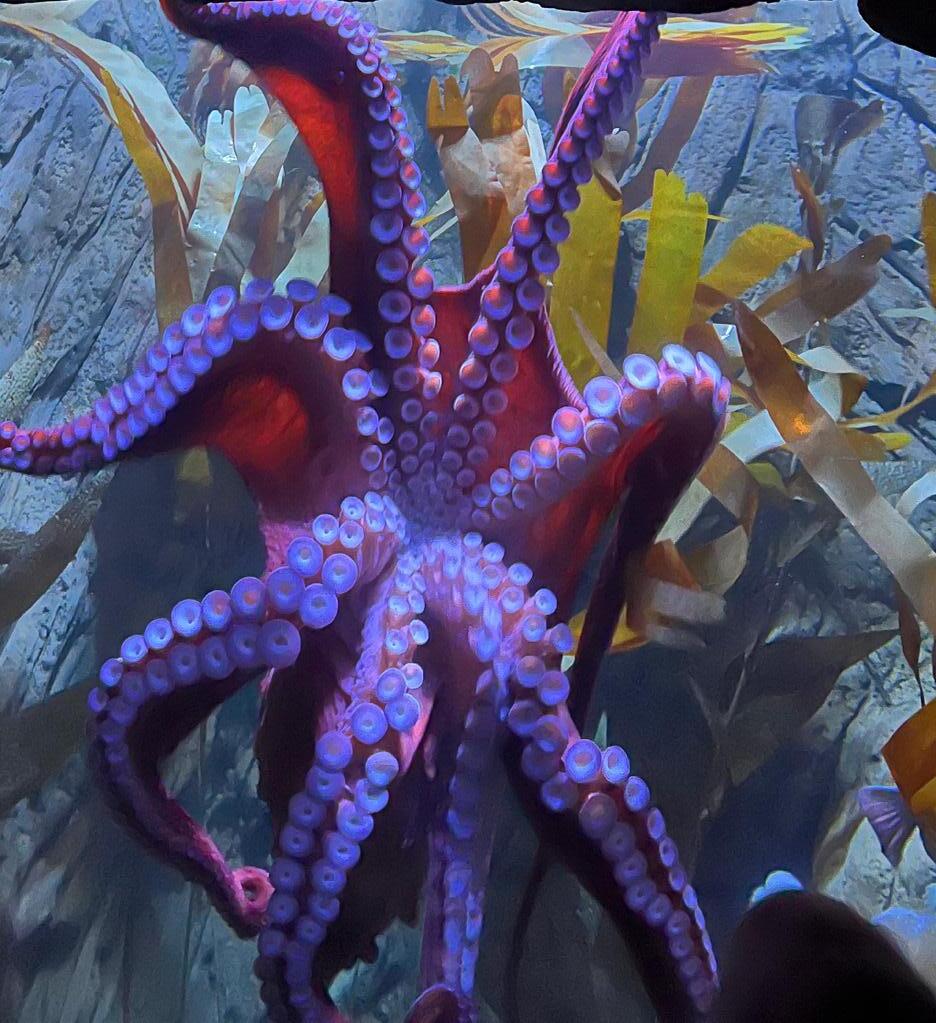
visitors.
The aquarium’s partnership with USU will provide QCNR students with internships and field trip opportunities, and someday soon, Atwood hopes to launch the first marine biology major in Utah.
During a recent dinner conversation with my family, I learned my mom dreamt of going to school for marine biology but was hindered by the lack of options in Utah. Who knows what her education could have looked like if this partnership existed when she was in college.
The ocean is full of systems and forces scientists are only beginning to understand, but one thing is certain: It’s the Earth’s lifeblood. I hope more educational institutions follow my university’s lead by stepping away from teaching only what seems logical and instead finding a way to teach what’s important.

Avery Truman is pursuing environmental studies and geography. When she’s not working in her position as the Utah Statesman lifestyles editor, she enjoys writing for NASA.

By Samantha Isaacson STATESMAN REPORTER
Pumpkin Plunge dove right in with its big debut at USU on Oct. 29. The event was held at the HPER in the diving area of the pool.
The event was a diving competition with a twist. For those who competed, they had the option to come dressed up in a costume.
Macy Gustavus is the coordinator of aquatics & safety for Campus Recreation. She oversees programming and daily operations at the HPER pools.
Gustavus said they got the idea for a diving competition from a few of the competitions the Red Bull company has hosted in the past, specifically their Flugtag competition.
“This event is a spin-off of Red Bull water and diving competitions,” Gustavus said. “When this idea came to mind, the Flugtag was the main inspiration.”
The Halloween-themed competition was graded by a panel of judges, with the winner receiving a “boo basket” full of Halloween treats and prizes. People were welcome to come and cheer on the contestants during the event.
Participation was free, and the participant cap was set at 40 people.
Olivia Schneider is the coordinator of competitive sports at Campus Recreation.
Schneider stated that the judges for the competition were picked from USU staff and students.
“We are going to have a panel of exclusive USU students and staff that will judge the diving competition,” Schneider said.
The judges rated the dives by style, splash, overall fun and creativity of the costumes. The winner was Chase Gunnell dressed up as a lumberjack.
Baily Kruzan is the coordinator of marketing for Campus Recreation.
Kruzan said one of the goals for the event was to bring attention to Campus Recreation.
“This year, we’ve really been trying to get students
to know about everything that Campus Rec offers to them,” Kruzan said. “Macy then had this idea, and we thought it would be another great way to get people into that space.”
Schneider said another goal of the event was to bring students together to have fun in a unique way.
“This is a fun way for students to relax and have a night of fun,” Schneider said. “We love the fall and want to offer more activities to celebrate this holiday.”
Gustavus said the event was a great way to show USU students the HPER’s facilities.
“The pool is a great space that has a lot of potential for student involvement, and I think this is one of those big steps towards creating more fun and quirky programming for our student body,” Gustavus said. Schneider said something that makes this event unique was the costumes.
“This event is special because there are not too many days in the year that you can wear a costume,” Schneider said. “It will be exciting and different from what we have offered in the past.”
Kruzan said they hope to continue to host the event in years to come.
“The hope is that this will be a new fun event for students to enjoy and hopefully look forward to in the future,” Kruzan said.



Samantha Isaacson is a junior majoring in journalism with a double minor in art and psychology. She loves to read and spend time outdoors.
— a02346802@usu.edu
“Melon Collie Radio,” hosted by Tanner Merritt, features slowcore, shoegaze and emo music with a focus on Utahbased sounds. The show also features personal stories that helped people through hardships. You can tune in Wednesday from 5-7 p.m. on Aggie Radio 92.3 KBLU-LP.





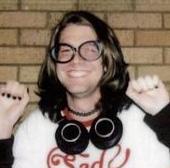









The turkey is also known as pípila, turkey, pípilo, huilo, totol or guajolote.


The word guajolote comes from the Nahuatl huexólotl and can be translated as large monstrous bird.

By Mark Greenwood STATESMAN REPORTER
In the Intermountain West, shooting sports are found anywhere you look. Sports like hunting, sheet shooting and others are incredibly common among those that live between the wildlife-filled mountains of the West. For Utah State, that means it has student body that is well acquainted with shooting and possess a skillset that not many other university students would have.
The Shooting Club at Utah State capitalizes on those skills and gives students an opportunity to develop their shooting abilities and compete with other students and schools. The club competes in three different categories at competitions: trap, skeet and sporting clays.
“A lot of people have only shot trap or sporting clays previously, but we kind of encourage everybody to compete in all of them,” said Wade Hendrickson, the club’s vice president. “By practicing one, you’re improving your ability at the other ones as well, so we encourage everybody to compete in all of them. Sporting clays is typically the crowd favorite, however.”
According to the National Shooting Sports Foundation website, trap shooting is the oldest shotgun shooting sport in America. Trap shooting is done in a squad of five shooters, each standing at a different station on the shooting course. Each shooter has five shots to hit five clay tar-
gets from left to right that are thrown onto the course in different locations.
Skeet shooting is like trap shooting, with five shooters stationed at eight different positions that consist of two shots each. Clay targets are thrown onto the course from two locations: one 10 feet from the ground and one three feet off the ground. Shooters compete by taking out as many as of the 24 clay targets possible, with the first missed target getting repeated.


Mark is a sophomore at USU studying economics and finance. He’s an avid LA Dodger fan and loves playing tennis and skiing.
— mark.greenwood@usu.edu


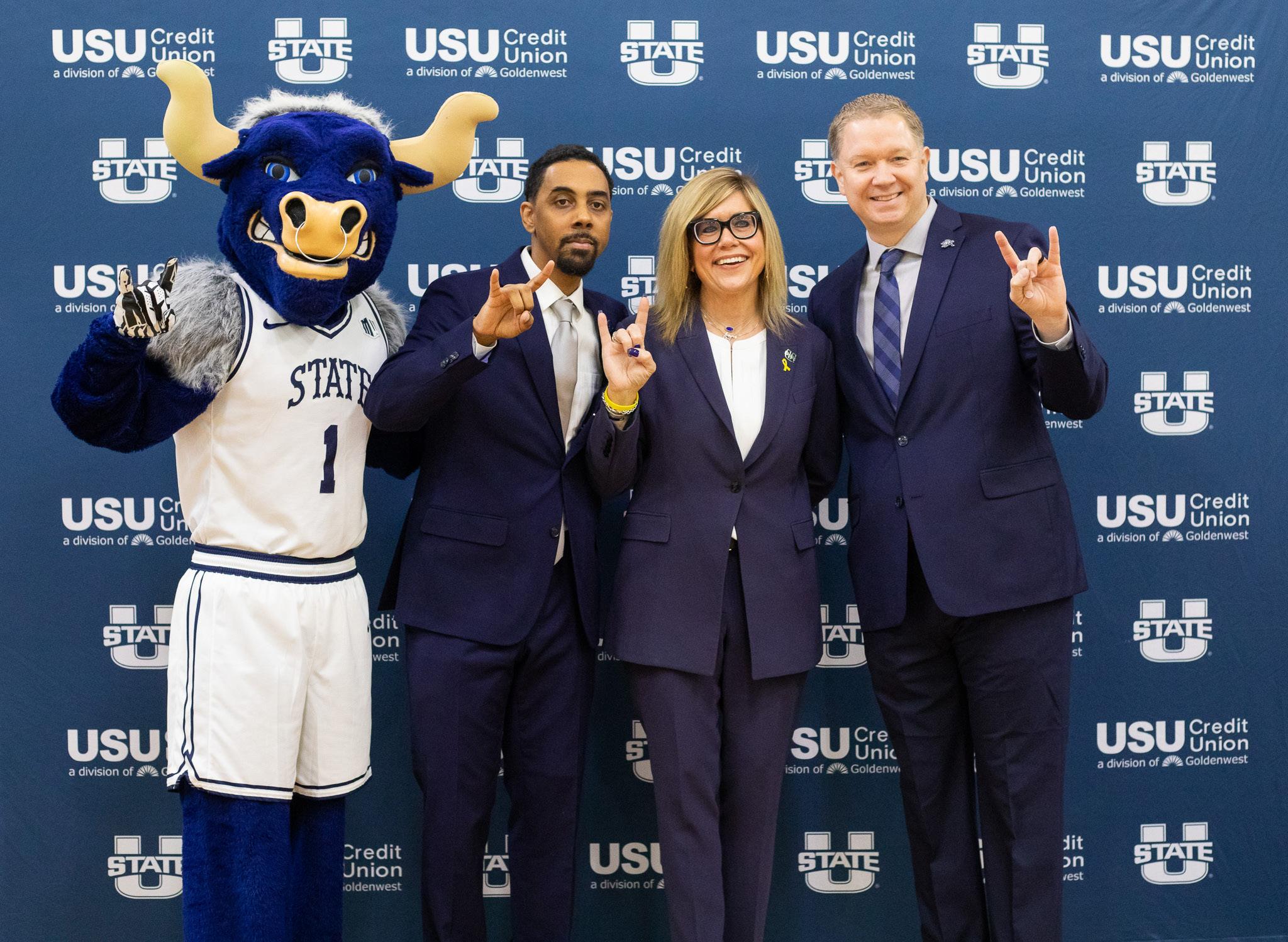
a regular season Horizon League championship and a postseason appearance in the National Invitation Tournament.
Calhoun looks to continue his upward trend while leading a USU basketball program that’s become familiar with winning teams and postseason appearances in recent years. Despite spending his last seven seasons in Ohio, the Utah State program is not entirely foreign to Calhoun.
practices, there has to be a real level of commitment across the board from the entire coaching staff, the entire organization.”

— mark.greenwood@usu.edu
By Mark Greenwood STATESMAN REPORTER
Utah State men’s basketball has been the pride and joy of Utah State athletics over the last several years. This is impressive considering Utah State basketball has gone through four head coaches in the last five seasons. After Craig Smith left to be the head coach at the University of Utah in 2021, Ryan Odom came to town as his replacement. After just two short seasons, Odom left for VCU and Danny Sprinkle was brought in. In an even shorter stint, Sprinkle was hired at Washington this offseason after just one season in Logan. With the exit of Sprinkle, the head coach search ramped up for the Aggies for the second time in as many seasons. After a search that has become all too familiar for the USU athletic department, Jerrod Calhoun was hired on March 30, 2024.
“Jerrod Calhoun embodies all the qualities we are looking for as the next leader of our men’s basketball program,” said Utah State Director of Athletics Diana Sabau at the time of his hire. “He is energetic, enthusiastic, a player’s coach and is motivated to keep our current student-athletes in Logan. He is a formidable recruiter, an exceptional motivator and has a keen understanding of the competitive nature of NIL and will be a great partner in growing the Blue A Collective.”
Calhoun came to Logan after spending the previous seven season as the head basketball coach at Youngstown State in Youngstown, Ohio. In his last two season with the YSU Penguins, Calhoun led the team to back-to-back 20-win seasons for the first time in their Division I history,
“I probably watched over half of their games last year, so I knew the roster inside and out. I had followed Utah State basketball from afar for a number of years. I love what Stew Morrill used to run with the two-guard series, I loved a lot of the actions Craig Smith and Ryan Odom ran. I real ly studied those guys from a bas ketball standpoint,” Calhoun said in an interview with The Utah Statesman. “Had great respect for Utah State in general and the history that they’ve had for a long, long time. And those are the programs that you study and you can learn a ton from. I just love the way they played over the years.”
That history at Utah State has not come without some turbulence, especially from the head coaching perspective. Three head coaches in three years is not ideal for any program and certainly takes its toll. On Calhoun’s first game in the Spectrum in an exhibition game against Weber State in mid-October, he was initially denied entrance by the security guard who didn’t know who he was.
“I was walking in the building today, and the security lady didn’t know who I was. She said, ‘Who are you?’ And I said, ‘I’m the head coach, and I’ve got to get into the Spectrum,” Calhoun said after the game.
Luckily for the Aggies, the constant head coaching turnover has been a result of resounding success on the court and continual postseason play. In the last four seasons, Utah State has won two conference championships and made the NCAA Tournament three times and the NIT once. The winning culture that has been created at Utah State brings some natural pres sure to Calhoun in his first year. Even with the pressure and the expectations, Calhoun is ready for the challenge. “I think you have to want those expectations. You have to approach it every day with a sense of urgency,” Calhoun said. “Whether it’s in recruiting, whether it’s in fundraising, whether it’s time with your players, your
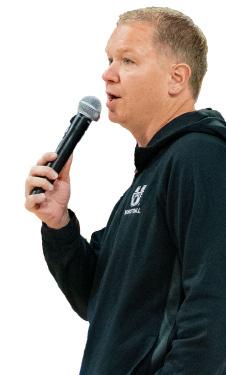
Utah State University welcomes the 2024-25 women’s basketball season with new head coach Wesley Brooks.
gained experience in basketball programs such as Michigan, Utah, North Texas, Texas Southern, and Robert
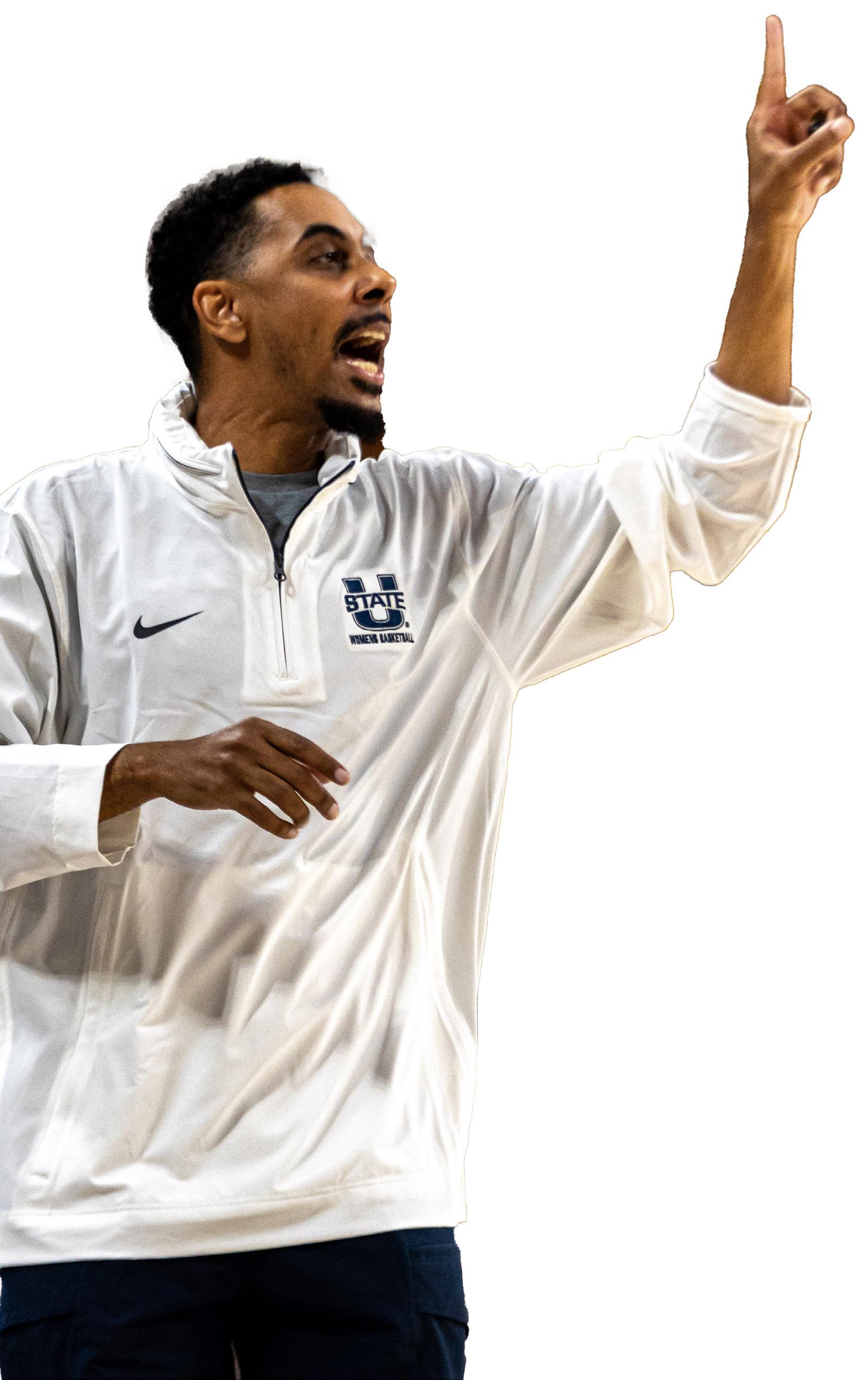

to coach for Aggie nation, Brooks brings his wife Yohanna and daughter Elsa to Cache Valley. For Brooks, basketball is a
“Our goal is to win championships,” Brooks said. “Yohanna, Elsa and I look forward to settling into the
At home, the Aggies faced off against Westminster University for an exhibition match last week where they started off the season on a 94-70 win. Coming off a win is a confidence booster for the start of
“We have to continue to play our game,” Brooks said. “We still have a lot to clean up and we’ll work on that.” Brooks continues to look ahead, encouraging the players to be diligent but have fun.
“The only way you play at pace is by practicing at pace,” Brooks said. “One of our goals is to be one of the
High expectations and keeping pace means obsessing over the small things. His role can feel heavy, but Brooks is passionate about the details of the game. Former players and coaches noted Brooks’s joy for the
“He shows up every single day and gives 100 percent of himself to whoever he is surrounded by,” said Jacy Sheldon, former women’s basketball player at Ohio State University. “He’s got great energy and I’m excited to see
his impact on Utah State.”
Starting fresh comes with a challenge, but with a season ahead of them, the Aggies are excited to see where Brooks will take the reins.
Utah State University Vice President and Director of Athletics Diana Sabau said of Brooks and his goals: “Under his leadership, we look forward to advancing the trajectory of women’s basketball at Utah State University.”
Brooks will take USU back to action against Kansas City University at the Dee Glen Smith Spectrum, a game Brooks said will be a “real test.”


If she’s not writing or reading, she can be found at any competitive event or game night, throwing a ball or yelling at a card game.

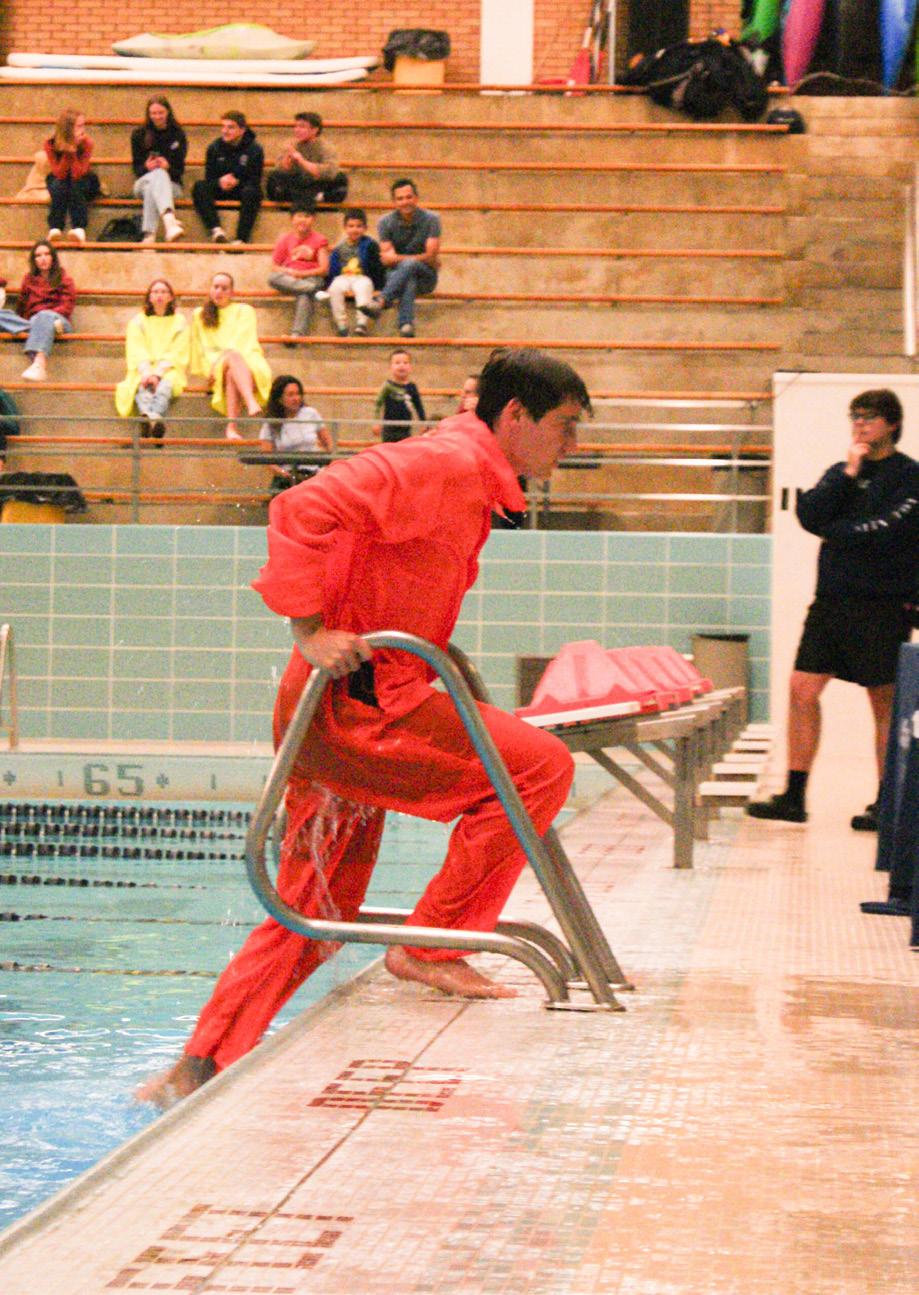


Alyssa Wangsgard is a freshman at Utah State. She loves photography and taking pictures of everything! When she’s not taking pictures, Alyssa enjoys being outside, running, and hanging out with her friends.
— a02446198@aggies.usu.edu

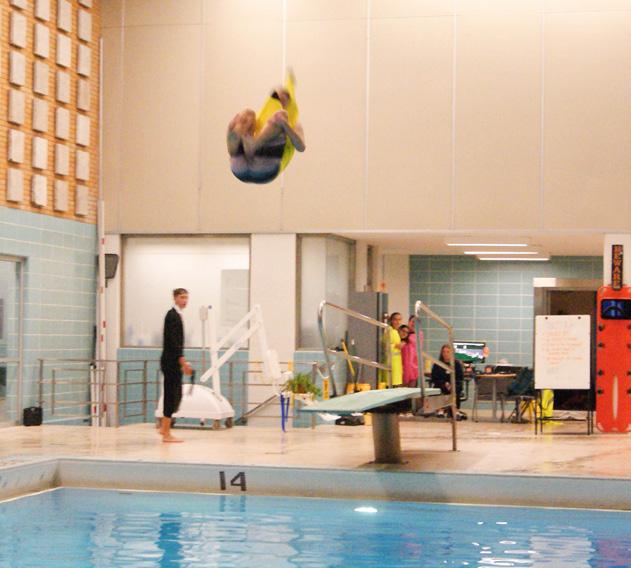





By Leah Call STATESMAN REPORTER
Hit play on Little Moon’s newest record, “Dear Divine.” Close your eyes and take a deep breath. Allow willow trees shrouded in fog and dewy greenery that sparkles in the sun to come into view. Allow yourself to be enveloped in the enchanted universe the record encapsulates.
Hailing from Springville, Utah, Little Moon is a sixpiece band with Emma Hardyman at their center. “Dear Divine” is their sophomore album, following “Unphased” in 2020.
The banjo, harp and piano accompanying the 12-track record aids in capturing the major themes in mythology, spirituality and creativity. This record is a swirl of contradictions examining love and grief, with tracks exploring Hardyman’s husband and Little Moon guitarist Nathan’s heartache after losing his mother.
Little Moon was the winner of the 2023 NPR Tiny Desk Concert, and Hardyman’s unbelievably impressive fouroctave range makes for an ethereal and other-worldly listening experience. The cutting lyrics and her operatic tone is a sound garden of the bittersweet variety. “It holds both love and grief and speaks to the importance of those attributes interchanging, intertwining and dancing together. Those are both really important components to deepening my own humanity,” Hardyman said in SLUG Magazine’s most recent episode of their podcast, “SLUG Soundwaves.” “This album became a journal or an installation and a sort of reverence toward the messy, complex reality of what we call love and what we call grief.”
Mixed and engineered by Provo musical staple Bly Wallentine, “Dear Divine” proves Little Moon’s ability to
thrive in fluid, undefined spaces and their refusal to box themselves into a single genre.
Tracks like the ethereal folksy piece “now” and the mellow, harmony-driven rock song “messy love” beautifully reflect the chaotic nature of existence. “now” delves into Hardyman’s challenging search for love and trust — qualities often absent in her environment — while “messy love” thoughtfully examines how partners can highlight each other’s imperfections. The track “kind, kind home,” creates a rich tapestry of familial love. This song feels like soft rainfall on my skin as she croons, “feeling numb/feeling all alone/I will try to be a kind, kind home.” The plucky acoustic guitar on “holy and sweet” and the harp floating above many of the songs gives way to the religious undertones before Hardyman ever sings her first note.
The last track “to be a god” most poignantly approaches Hardyman’s relationship growing up as a member of the Church of Jesus Christ of Latter-day Saints and her spiritual journey as it is now. The lyrics include, “I didn’t know how to trust myself/I numbed my pain since I was twelve/I think to be a god is to be/pleasantly surprised by how much more you can love.” This song is soft and unassuming, but the lyrics are so affecting because Hardyman sings a capella, without any music to overpower the message.
Though grief has never touched me the way Hardyman’s lyrics describe, I relate to the idea that life can be unrelenting sometimes — and yet so simultaneously delightful. The little pains and aches that accompany existence won’t keep me from bounding through meadows of daisies, eating raspberries and doing cartwheels.
As a 23-year old about to leave the beautiful home and community I’ve found in Logan, this album allows me to

explore my own kind of grief — of a place and a home. I will mourn Sunday mornings at Caffe Ibis and nights walking home from the White Owl, bike rides around “the Island” as the autumn leaves change color and walking around wistfully as the snow swirls. But I will listen to this album as I drive away and sit with it. I will sit with the messy and vulnerable feelings that moving on comes with. And this album will reassure me that everything will be okay.
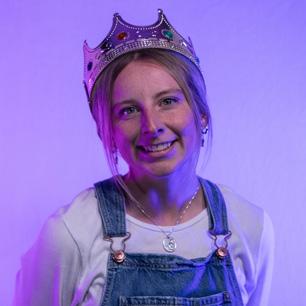
Leah Call is a senior studying print journalism. When she is not furiously studying the AP Stylebook, she enjoys listening to the Velvet Underground and reading the wise words of Patti Smith in her beloved blue hammock. — leah.call@usu.edu
— Emma Hardyman


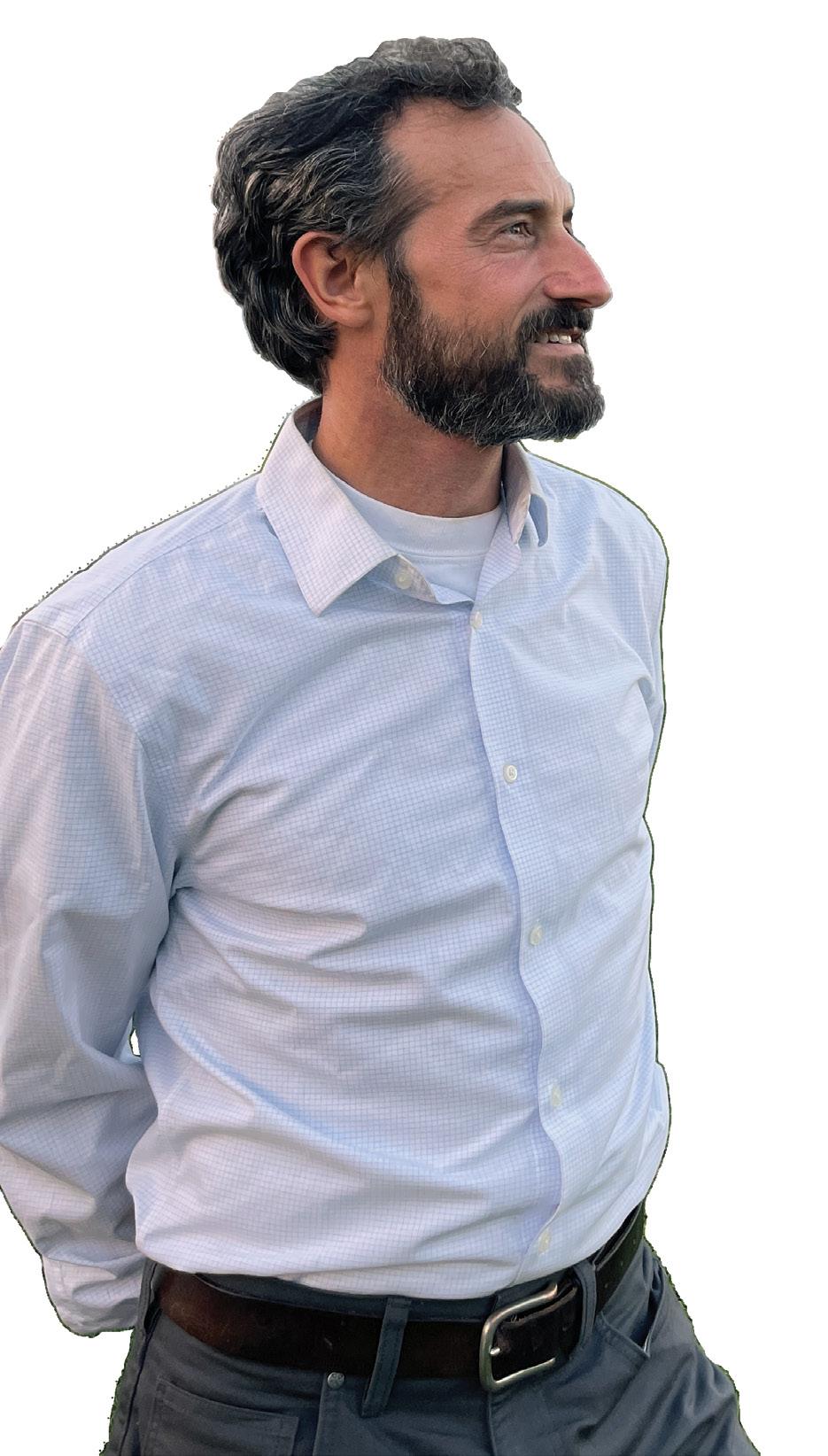



www.sudokuoftheday.com.


